Pattunulkarar – The Silk Weaver
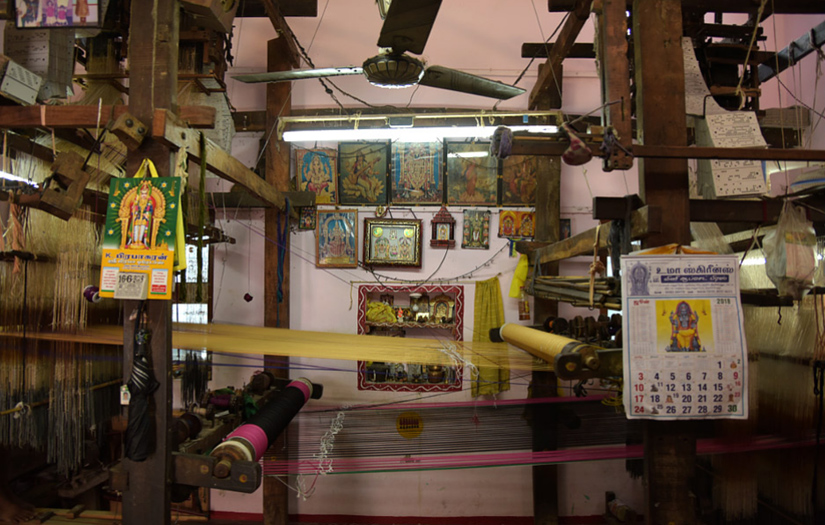
Have you ever wondered how a Rubik square works? Scattered colors find their counter parts to bring out a new meaning… Similarly the weavers of Saurashtrapuram lane of Dindigul district of Tamil Nadu, located in the foothills of Sirumalai hills in the vicinity of hundreds of temples…greet you with houses painted in bright colors & as you enter their tiny but warm households… an artistic display of their tools, bundles of colored yarn unspooling from glass jars and a nonstop chattering of wooden shuttles awaits you with pictures of Gods & aromatic smell of flowers and incense filling up the walls and marinating the ingredients held within.These fabrics… fill up with the understanding of nature, their surroundings & learnings of their past & present… become a canvas for five senses to indulge in.
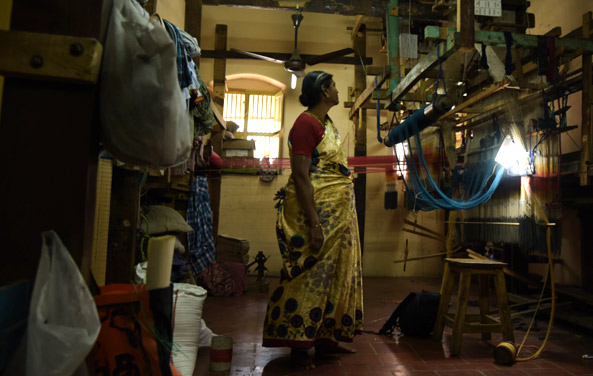
Every now & then their humble abodes have learners & onlookers to witness the magic of their hands… few inquisitiveeyes look closely at the fine woven sari & in return its peaks to them of generations it has witnessed through the lens of traditions… passed down from one hand to another… each adding a new character to it. Amazed by the sudden revelation! One of the onlookers mutters to himself “these colors,motifs seem to have so much morethan what meet the eyes… an amalgamation of many cultures”. Such keen remarks evoke from an otherwise quiet weaver tales“these fine weaves have a story of their own to tell.”

“It all begun years & years ago… from the land of Surashtrain Gujarat… where Surashtrian weavers were known for their fine weaving. With a swish of their hand they would turn lifeless threads into finest of fabrics ever seen. Everything was hail & holy… until one day when their neighborhoods were attacked by Mohamed of Ghazini, destroying the harmony around… forcing the weavers with many others to move out. They moved along… in search of peaceful places… learning through new experiences from places they stayed at & the people they met… building a story within these threads. Wandering through the vast expanses of this country, from North, Centre and South of India, showcasing their skills,they gathered appreciation from one and all.

Eventually, they reached Madurai & mesmerized by the spiritual aura, finally settled in & later dispersed to various other places in Tamil Nadu from there, one of them being the Dindigul region. Their skill earned them the title of “Pattunulkarar”, meaning “the silk weaver”, for the fineness of their weaves. Though their mother tongue remains Saurastrian, they have picked up Tamil very well and being the only language of communication in the region, it has also entered their households as the prime communication language. Their food habits at home are also a mix of both, Gujarati and Tamil cultures.
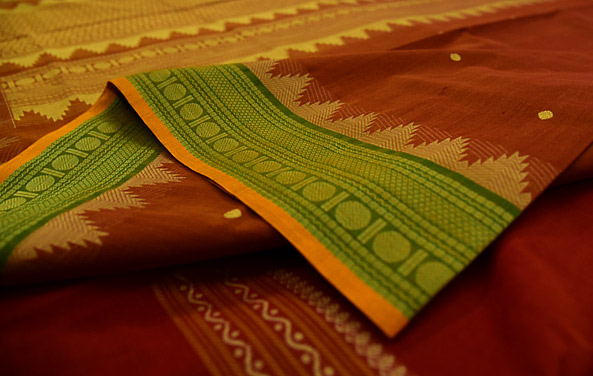
Dindigul is best known for its Kanchi cotton saris today, historically made in kanchpuram, before they switched entirely to silk and ‘cotton Kanchi’ fell into Dindigul’s share. Unlike most clusters in south that avoid weaving black, Dindigul offers a variety in this color. Dindigul has five clusters under it from Dindigul Black One, Dindigul Black Two, Dindigul Black Three, Palanito Toppampatti. Dindigul Black One has 1760 weavers whereas Black two has 2500 weavers weaving similar kind of saris on double jacquard looms since the beginning of the cluster. Dindigul Black Three, also known as Aathur in Chinalapatti area works on tie-dye Single-Ikat saris, followed by Palani&Toppampatti.

Weaving here is done on Double jacquard looms, one jacquard is for the Border & the second one is for Pallu. Jacquard border and Pallu are of 120 hooks each. Each loom set-up has about 3-4 shuttles and 4 paddles. A weaver takes around 3 days to finish a sari, where one day is given to making of Pallu & intricacies of silk may take a weaver 2.5 -3 days to complete a Pallu design. These saris are locally wet dyed from approved dyers. For azo-free vegetable dying they are also sent to Pollachi. Pre-loom processes of warping and sizing are done in Chinnalapatti or Palangudi and finally the warp is set on the loom by the weaver himself. Weft yarn is inserted in the Pirn using Chakra. Through a single wrap, ten saris are made in one month’s time. 7-8 wraps are made per design with different color combinations.
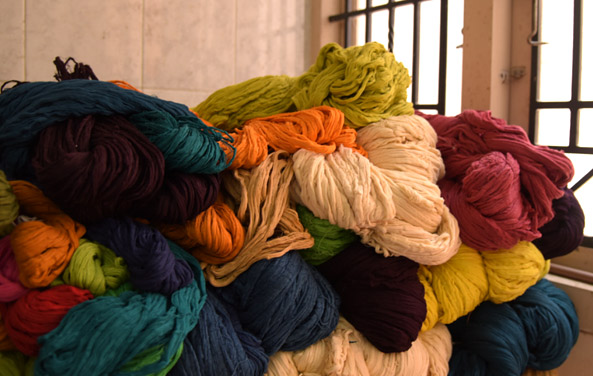
“Bemberg cotton”, a miss pronunciation of “Bumper cotton”, which means “new cotton” is used as weft & Art silk (artificial silk) as wrap in weaving. Cotton is sourced from National Handloom Development Corporation or farms of Maharashtra. A new range of saris weaving pure silk from Banglore & Art silk from Surat together is being introduced as a premium variant. Warp and weft of 80s cotton are used in the saris. The body has 80s combed cotton with 3200 csp (count strength product). 20/100 cgm (cotton gas mercerized), a fine and lustrous variant of cotton is used in Border &Pallu. For silk saris, 75 Diner wrap & 80s combed yarn for weft is employed.

These cotton saris come in pleasing color combinations to suit the modern taste as well. Interesting blend of traditional motifs like Temple Rekku, Peacock, Mango butta or elephant with modern patterns, sitin balance. Mubbakam, a three part sari is divided equally horizontally along its 6.2 meters of length (5.5m of sari + 70cm for blouse). There are about 25-30 designs in this pattern. Black is a color the weavers of this cluster do not hesitate to work with, as against every other cluster, where it is considered inauspicious. The Pallus are the most elaborated part of a sari design, weavers put their skills together for days to bring out through them; glories of past and trends of today…”
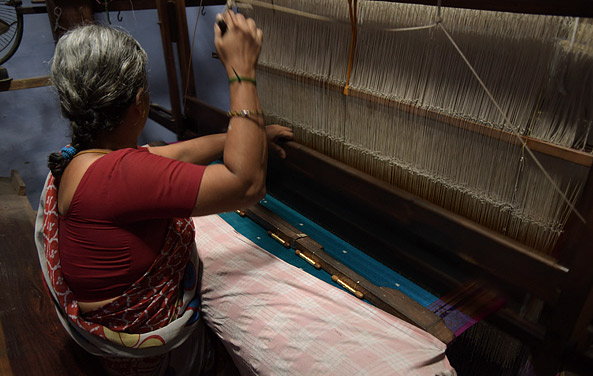
These people of tradition… weave traditional fabrics, both on their looms as well as in their social lives… and there is a sense of balance they seem to have acquired in both the skills…. deeply intertwined and freely flowing into each other throughout the day… Old beliefs acquired from places known and unknown, with fresh cumulative wisdom of everyday life, the sari, in itself is an artistic expression of the one it is draped around…

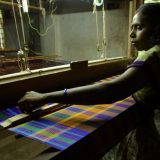
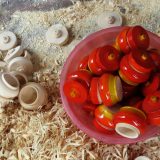








Madhura Tokekar
This information really made my day. I felt that I am so unfortunate that just two days ago I came back from Kodiakanal to Pune. Had I read this earlier I would have visited the weaver’s Dindigul. Anyway, that gives me a reason to visit Kodaikanal and Dindigul again.